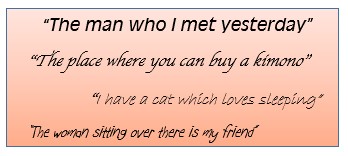There are many types of relative clauses…
Defining relative clauses provide information we need to explain something. Without them the listener would be confused. Non-defining relative clauses provide bonus information, which is not required to understand the main clause.
Defining relative clause examples:
The man who lives across the street drives a nice car. [The man drives a nice car. > Which man? > He lives across the street.]
This is the shop which I bought the TV from.
Non-defining relative clause examples:
Peter Jones, who lives in LA, was recently seen in London.
My neighbor has a nice car, which he bought last year.
1. Defining relative clauses
Defining relative clauses use a relative pronoun or adverb at the start of the defining relative clause: who, which, that, when, where or whose.
a. who/that
We use ‘who’ or ‘that’ to talk about people. ‘That’ is a little more common in everyday speech.
She’s the woman who owns the bookshop near my house.
He’s the man that I saw waiting outside your house.
b. which/that
We use ‘which’ or ‘that’ for things. ‘That’ is a little more common in everyday speech.
I bought a TV that was in a sale.
The curry which I ate for dinner yesterday was really tasty.
c. Other pronouns
‘When’ is used when we refer to a time, or a situation that happens at some time. ‘When’ is followed by a subject.
Winter is the time of year when I’m happiest – I love skiing. [subject = I]
I don’t like it when you shout at me. [subject = you]
Note: ‘When’ can sometimes be replaced by ‘in which’
Winter is the time of year in which I am happiest.
‘Where’ is used when we refer to a place. ‘Where’ is followed by a subject.
This is the church where Tom got married. [Tom = subject]
I love cities where I can visit lots of museums. [I = subject]
Note: ‘Where’ can sometimes be replaced by ‘in which’
This is the church which Tom got married in.
Note: I like cities where which have lots of museums. [This is not followed by a subject, so ‘where’ is not possible]
I was born in a town where which is near London. [‘where’ is not possible.]
‘Whose’ is used when we refer to the person that something belongs to.
She knows a man whose house has 15 bedrooms!
d. Omitting the relative pronoun
We can usually leave out ‘who’, ‘which’ or ‘that’ if it is followed by a subject. However, we cannot leave out ‘when’, ‘where’ or ‘whose’.
The woman [that/who] we spoke to was really kind.
(we = subject, ‘that/who’ is optional.)
The car [that/which] he drives is really nice.
(he = subject, ‘that/which’ is optional.)
The town where I was born is near London.
(I = subject, but ‘where’ is not optional.)
We can’t usually leave out the relative pronoun if it is followed by a verb.
The assistant that helped us was really kind. (helped = verb, can’t omit ‘that’)
e. Reduced defining relative clauses
We can often omit the relative pronoun ‘who’, ‘which’ or ‘that’ together with the verb ‘be’ for passives or present or past participles, but not with adjectives.
The man [who is] sitting on the chair is my brother.
The car [which is] parked over there is going to get towed.
The temple [which is] called ‘Kinkakuji’ was destroyed by fire in 1950.
The man who is old was my boss. [‘old’ is an adjective and ‘who is’ cannot be omitted.] [‘The old man was my boss’ is more common in this situation.]
We can often omit the relative pronoun ‘who’, ‘which’ or ‘that’ with the verb ‘be’ if a prepositional phrase follows.
I like the dress [which is] over there.
Have you seen the museum [that is] on Main Street?
2. Non-defining relative clauses
Non-defining relative clauses use ‘who’, ‘which’, ‘when’, ‘where’ or ‘whose’ to add extra information. The information is not required to understand who or what we are talking about.
Defining: The man who lives next door to me is a doctor. [Which man is a doctor? The man who lives next to me. ‘Who lives next to me’ defines which man we are talking about.]
Non-defining: Mr. Suzuki, who lives next door to me, is a doctor. [Mr. Suzuki is a doctor. ‘Mr. Suzuki’ already defines which man we are talking about. ‘Who lives next door to me’ is extra information, but not necessary for understanding that Mr. Suzuki is a doctor.]
‘That’ cannot be used for non-defining relative clauses. Commas are used to separate the clauses.
Tom, who is sitting by the door, is my boss. [Tom, that is sitting by the door, is my boss.]
London, where I was born, is the capital of England.
Spring, when the flowers bloom, is my favourite season.
Einstein, whose theory of relativity was a masterpiece, was always very modest.
I like Ginkakuji temple, which is located in north-east Kyoto.
a. Which for expressing opinion.
‘Which’ can be used to add an opinion about what was said before.
I liked the movie, which surprised me.
He’s never been to America, which shocked me.
b. Reduced non-defining relative clauses.
As with defining relative clauses, we can reduce non-defining relative clauses too.
Fushimi Inari shrine, [which is] located in Kyoto, is a famous shrine.
My sister, [who is] sitting over there, is always happy.
Labor Gakuen, [which is] on Shijo Street, offers English lessons.
ラボール英会話教室.png)
